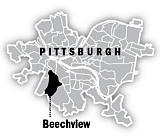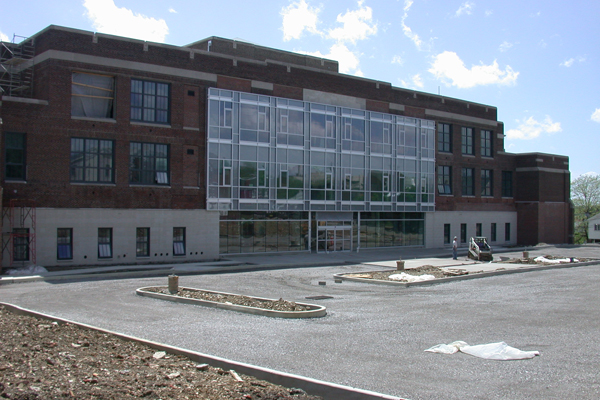
Category Archive: Landscapes
-
City Will Return Lost Art to Public
Friday, November 19, 2010By Diana Nelson Jones, Pittsburgh Post-GazetteFive sculptures that were stored for years in a public works warehouse are being put back on pedestals four years after one artist’s persistent queries led to their discovery.
Thursday morning, a crew from Mangery & Sons hoisted Peter Calaboyias’ stainless steel sculpture “Five Factors” into place on a concrete slab behind the baseball field in Mellon Park, Shadyside.
Standing beside one of the six-sided skewed cylinders, he beamed and said seeing it in public was a thrill “after all these years.”
“Five Factors” was one of four sculptures chosen in a 1971 public art competition and placed atop the garage at the Squirrel Hill branch of the Carnegie Library. They were among the first contemporary sculptures to be displayed as public art in the city. At the time, the city required that 1 percent of the construction budget for a public building be spent on art.
Thomas Morandi, Edward Bordas and Jim Myford were the other artists whose works were chosen.
Years ago, the sculptures were removed, either for repair or to accommodate changes in use of space. Mr. Calaboyias thought his sculpture had been stolen and sold for scrap, he said.
Library officials said the works had been sent to a restoration company in the 1990s. But at some time after that, the public works department retrieved the works when the company went bankrupt and stashed them in a warehouse under the 62nd Street Bridge.
They stayed there until 2006, when Councilman William Peduto’s staff learned about the sculpture and contacted Mr. Calaboyias.
The artist, who had raced to the warehouse to make the identification, said it was both distressing and exciting to see them.
“Five Factors” was inspired by ancient Greek stelae, or cylindrical stone markers that were inscribed with words or carvings, he said.
Half of a Richard King Mellon Foundation grant of $300,000 was used to restore and relocate the sculptures. The fifth was the work of Aaronel deRoy Gruber. It was originally on the portico of the City-County Building, then on the site where the David L. Lawrence Convention Center is now. It was stored with the other four.
Morton Brown, public art manager for the city, said the five pieces were in “the most dire need” of conservatorship among the city’s collection. Three went to the McKay Lodge Conservation Lab in Ohio. Mr. Myford and Mr. Calaboyias did their own repairs; in fact, Mr. Calaboyias’ is an exact replica of the original, which “had too many dents to be pounded out to save,” he said.
The Bordas piece has to hang on a wall, said Mr. Brown. Its new location has yet to be decided.
“I’m trying to find a city-owned facility that has an architectural style” that’s the right fit for “two abstract, elongated triangles welded together and painted red. Really quite beautiful. But I haven’t found the right place yet.”
The sculpture is under 200 pounds, he said.
Mr. Myford’s work — two elongated rectangular forms angled like fingers aloft — was installed two months ago in Grandview Park in Mount Washington, just above the historic stone steps off Bailey Avenue.
Mr. Morandi’s and Ms. Gruber’s works will be installed in Mellon Park.
With the rest of the grant, Mr. Brown and the Greater Pittsburgh Arts Council’s Office of Public Art will determine which pieces should next be restored, weighing costs, deterioration, visibility and the prominence of the artist, he said.
“We have 110 pieces in the collection and we have about 21” identified as most in need, he said.
“If we can get five more done next year, then we will leverage money for the others.”
-
Buying Here: Beechview
Saturday, November 13, 2010By Kevin Kirkland, Pittsburgh Post-Gazette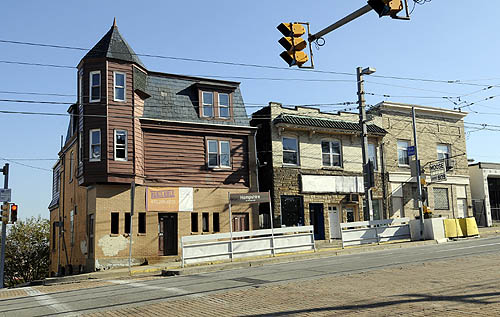
The city's Urban Redevelopment Authority has foreclosed and put on the market four buildings -- 1600, 1601, 1602 and 1619 Broadway Ave. == with hopes of enticing developers to invest in this business district and begin its turnaround. Larry Roberts/Post-Gazette
The panoramic views of the South Hills from the third-floor balcony of 1600 Broadway Ave. are a sight for sore eyes — especially if you live in Beechview.
For the last five years, residents of that city neighborhood and riders on the LRT have had to look at mostly shuttered storefronts on Broadway that were bought — then abandoned — by investor Bernardo Katz. The city’s Urban Redevelopment Authority has foreclosed and put on the market four buildings — 1600, 1601, 1602 and 1619 Broadway Ave. — with hopes of enticing developers to invest in this business district and begin its turnaround.
“Beechview is a very cool neighborhood,” said URA Director Rob Stephany. “I think its proximity to the T makes it interesting.”
Mr. Katz defaulted on millions of dollars worth of mortgages and more than $700,000 in loans from the URA that he used to buy these and other commercial properties in Beechview, Oakland and Mt. Lebanon. He fled to his native Brazil in December 2007 and was charged in absentia last year with federal wire and mortgage fraud.
Although most of the buildings were left to deteriorate, Mr Katz worked on the exterior and interior of the first floor of 1600 Broadway and briefly opened a Mexican restaurant there. The largest of the four, it’s now priced at $194,800. The newer storefront reflects its early 1900s construction while the second and third floors have a total of five apartments and another in the basement, with walkout access on Hampshire Avenue. The URA gutted the apartments to the plaster lathe, removing asbestos and all mechanical systems.
“That’s the way developers want it,” said Dave Majcher, URA senior construction coordinator.
Also gutted was the adjoining 1602 Broadway ($43,000), a former bar that has a new roof and a rickety rear addition that the URA says should be removed. Across the street is 1601 Broadway ($130,000), another former bar with a turret and a few architectural details that survived previous remodels — an original staircase and a columned fireplace mantel on the second floor. The views from its second- and third-floor windows are classic Pittsburgh, with small houses clustered along hilly streets.
A half-dozen storefronts separate 1601 from 1619 Broadway ($70,000), a small former video store with an intact three-bedroom apartment behind.
“It’s perfect for a small business owner,” Mr. Stephany said. “Someone could be in at a reasonable cost.”
The other three buildings, however, are suitable only for developers, he said. A feasibility study the URA commissioned last year estimated exterior and interior renovation costs at $588,799 for 1600 Broadway, $409,586 for 1601 and $457,866 for 1602.
“These are probably $600,000 events,” Mr. Stephany said.
Even with façade grants and streetscape loans, buyers would still be looking at construction loans of at least $400,000 for each building. Everything is not bleak, however. IGA plans to reopen the shuttered Foodland next to 1602 Broadway, and brothers Kevin and Adam Costa have purchased 1603 Broadway to open their Crested Duck Charcuterie, “an artisanal meat market.” At least initially, the apartments may be the hotter part of the properties.
“I do think the first floors will come,” Mr. Stephany said. “I’m not sure they will come first.”
Susheela Nemani-Stanger, a URA project development specialist, believes loft apartments would suit college students who appreciate their proximity to mass transit.
“They would be perfect for students from the Art Institute or Culinary Institute,” she said.
For more information on 1600, 1601, 1602 or 1619 Broadway Ave., Beechview, call 412-255-6612 or go to www.buyintheburgh.com.
SALES SNAPSHOT16TH WARD/SOUTH SIDE 2009 2010 SALES 138 147 MEDIAN PRICE $45,000 $62,000 HIGHEST PRICE $505,000 $380,000 17TH WARD/SOUTH SIDE 2009 2010 SALES 143 134 MEDIAN PRICE $121,250 $137,000 HIGHEST PRICE $800,000 $595,000 18TH WARD/MOUNT WASHINGTON 2009 2010 SALES 141 137 MEDIAN PRICE $12,000 $13,000 HIGHEST PRICE $750,000 $669,000 19TH WARD/BROOKLINE 2009 2010 SALES 462 467 MEDIAN PRICE $65,000 $68,000 HIGHEST PRICE $625,000 $465,000 20TH WARD/WEST END 2009 2010 SALES 245 208 MEDIAN PRICE $33,000 $31,800 HIGHEST PRICE $200,000 $255,000 29TH WARD/CARRICK 2009 2010 SALES 121 148 MEDIAN PRICE $49,000 $45,000 HIGHEST PRICE $133,000 $147,500 30TH WARD/KNOXVILLE 2009 2010 SALES 58 54 MEDIAN PRICE $9,900 $10,100 HIGHEST PRICE $77,000 $55,000 31ST WARD/LINCOLN PLACE 2009 2010 SALES 45 72 MEDIAN PRICE $66,000 $63,000 HIGHEST PRICE $147,400 $335,000 32ND WARD/OVERBROOK 2009 2010 SALES 115 119 MEDIAN PRICE $67,000 $73,000 HIGHEST PRICE $226,000 $229,550 MOUNT OLIVER 2009 2010 SALES 58 55 MEDIAN PRICE $16,201 $20,000 HIGHEST PRICE $79,500 $76,500 WEST HOMESTEAD 2009 2010 SALES 17 23 MEDIAN PRICE $43,100 $22,000 HIGHEST PRICE $169,900 $125,000 Beechview
At a glance- Website: www.beechview.org
- Size: 1.46 square miles
- Population: 8,772 (2000 census)
- School district: Pittsburgh Public (pghboe.net)
- Enrollment: 25,326
- Average 2010 SAT scores: 425 verbal, 446 math, 423 writing
- Taxes on a property assessed at 100,000 : $2,870; City: $1,080 (10.8 mills), school district: $1,392 (13.92 mills), county: $398 (4.69 mills), wage tax: 3 percent (1 percent to the city, 2 percent to the school district)
- Claim to fame: Named for the many beech trees found on its hillsides, Beechview (incorporated as a borough in 1905 and annexed to the city four years later) has the steepest street in hilly Pittsburgh, and quite possibly the world. Canton Street has a grade of 37 percent — that is, it rises 37 feet per 100 feet of run. So steep is the bottom half, that residents aren’t supposed to drive down it.
-
$25,000 Grant a Major Boost in Restoring Wilkinsburg’s Business District
Wednesday, November 10, 2010
Pop City Media
Wilkinsburg’s main commercial district on Penn Avenue suffers from a 38% vacancy rate, but a $25,000 grant from State Representative Joseph Preston Jr. to the Wilkinsburg Community Development Corporation is the most recent achievement for the growing two year old organization hard at work to revitalize their community.
A great deal of the grant money will be used for promotional materials that will make the transformation efforts in the business district more visible and help visitor’s better identify the borough’s locality.
“We’re going to be getting new light pole banners. We’re making a business district map and brochures that we can put online and in print form. We also do a monthly newsletter,” says Tracy Evans, the WCDC’s first full-time executive director, who was hired in June.
A major benefit entails the creation of a new WCDC website that will better connect the Wilkinsburg community, visitors, and businesses. According to Evans, the website will likely be up by Spring 2011.
Additionally, Wilkinsburg has partnered with TreeVitalize in order to apply for a grant that will allow for 500 new trees to be planted along Penn Avenue. While the grant is still pending, WCDC beautification coordinator Michael Yellets is currently working with local business owners to select the most suitable tree species for various segments of the Penn Avenue sidewalk.
Writer: John Farley
Source: Tracy Evans, WCDC -
Exhibit Celebrates the Many Styles of Homes in Beaver
Saturday, November 06, 2010By Marylynne Pitz, Pittsburgh Post-Gazette
A model replica of the Agnew-Anderson House, built in 1808, is among the exhibits in "Bricks, Mortar and Charm," an exhibition at the Beaver Area Heritage Museum. Bob Donaldson / Post-Gazette
BEAVER — Since 1802, this town 35 miles northwest of Pittsburgh has reflected the aspirations of the bankers, doctors, teachers, lawyers and politicians who inhabit its quaint streets and River Road, a lovely stretch of beautiful homes that overlooks the Ohio River.
Now, this community’s architectural aspirations are on view in a concise exhibition called “Two Hundred Years of Bricks, Mortar & Charm” at the Beaver Area Heritage Museum in downtown Beaver.
Local historians believe that a house built in 1805 and still standing at River Road and Market Street is the town’s oldest structure. Part of the home’s front section was built with hand-hewn logs that are still visible in the basement. The logs may have been salvaged from Fort McIntosh, a Revolutionary War structure built in 1778.
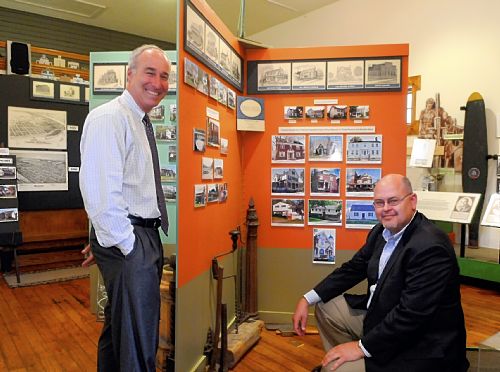
Edwards McLaughlin, left, and Mark Miner of the Beaver Area Heritage Museum take a look at "Bricks, Mortar and Charm," an exhibition that documents the architecture of Beaver. Bob Donaldson / Post-Gazette
Edwards McLaughlin, chairman of the museum’s board of trustees, spent weeks photographing homes all over Beaver for the exhibition, which examines the evolution of design styles in 50-year periods. His volunteer work correlates to his day job because he’s a partner in the real estate firm Bovard Anderson and a fourth-generation owner of the business.
With its 19th-century-style street lights and restored storefronts, Beaver retains its Victorian-era look. So it’s no surprise that from 1850 to 1900, plenty of Colonial Revival, Queen Anne and other Victorian-period homes were built. There’s also a smattering of Italianate, Gothic Revival and Romanesque homes.
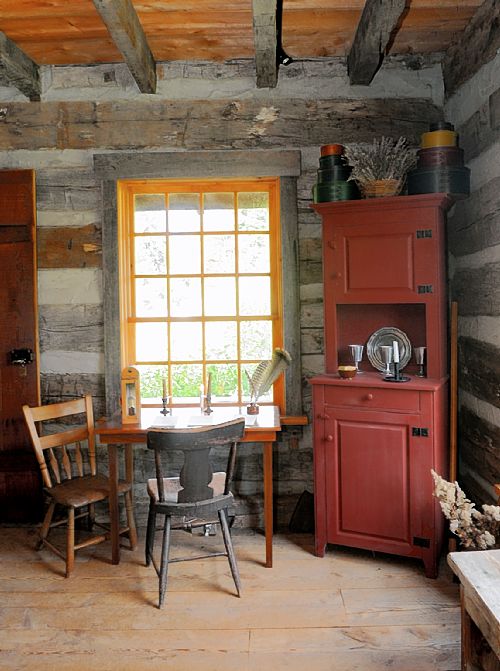
A replica log cabin is part of the Beaver Area Heritage Museum's permanent exhibit. Bob Donaldson / Post-Gazette
Surveyor Daniel Leet laid out Beaver, creating four squares in the center of town and four at its edge. Each one is named for a prominent resident or military leader. Agnew Square, for example, is named for Daniel Agnew, who was chief justice of the Pennsylvania Supreme Court. At Third Street and College Avenue, an exact replica of the clock tower that adorned the 1877 courthouse stands on the southeast corner.
A new century dawned and tastes changed between 1900 and 1950. As a result, Beaver has examples of English Tudor, Craftsman bungalows and Art Deco designs. There are even examples of Prairie-style homes, a Frank Lloyd Wright design ideal that emphasizes an open floor plan, horizontal lines, shallow roofs with broad overhangs and banks of casement windows with art glass.
The exhibition features an excellent model of Beaver’s 1877 courthouse plus a replica of the Agnew Anderson House. Both were made by Robert A. Smith.
Mr. McLaughlin is just one of several hundred volunteers who combined their collective, considerable elbow grease to transform a former Pennsylvania & Lake Erie Railroad freight house into the Beaver Area Heritage Museum 12 years ago. The building was a shambles with holes in the ceiling, thick grime on the floors and a basement packed with old dust.
Now, the museum sparkles. There’s a permanent exhibition about the Beaver region, an outdoor vegetable and herb garden with native plants and an 1802 log house that’s a replica of a frontier home.
Mildred “Midge” Sefton, a retired home economics teacher, oversees the volunteers, who meet regularly on Thursday mornings in the basement to accession, catalog and log onto a database each artifact and document that is donated to the museum. Judy Reiners of Beaver recently finished compiling family documents that belonged to Adolf Mulheim, proprietor of a wallpaper and carpet store from around 1880 to the 1930s.
-
Setback Won’t Deter Move of Historic House
Friday, November 05, 2010By Len Barcousky, Pittsburgh Post-GazettePaul Orange hasn’t given up hope that he will be able to buy and relocate the historic William Smith House in Mercersburg, despite a setback Thursday.
The house is on land owned by the MMP&W Volunteer Fire Co., which acquired the property in 2009 with plans to expand its aging facilities.
The board that oversees the regional fire company opened bids on Thursday for demolishing the 260-year-old structure but did not consider a proposal from Dr. Orange to move it.
Contacted after the meeting, Dr. Orange said he was advised that his offer to pay the fire company $100 for the building, rather than charge for tearing it down, had not been submitted in the right form.
The fire board, however, took no action on the demolition bids it received during its 15-minute meeting. That decision gives him hope that he still can reach an agreement to preserve the house, he said.
Joel Bradnick, a spokesman for the fire board, said the five bids would be forwarded to the fire company’s engineer for evaluation. He described Dr. Orange’s offer as a nonbinding “one-line memo.”
The low bid for demolition was $18,000.
“But why pay $18,000 to knock something down when you have someone willing to give them money to take it away,” Dr. Orange said.
The fire station and the Smith House are next to each other on Mercersburg’s Main Street.
If he is able to reach an agreement to move the house — either with the fire company or with the firm chosen to do the demolition — the next likely step would be to acquire a new location nearby. One possibility is a lot on the other side of Main Street, the site of a closed gas station.
Relocation and land acquisition could cost him as much as $100,000.
The Smith House was built in the 1750s. Constructed as a one-story cottage, it was greatly modified in the 19th and 20th centuries with the addition of a second story and porches.
News that the Smith House might be demolished attracted the interest of a museum in Northern Ireland. The Ulster American Folk Park has been developing plans to rescue the 18th-century first floor of the structure and move it to Europe. There it would become part of a collection of buildings with ties to Scotch-Irish immigration history. Several structures at the outdoor museum were moved from their original sites in southwestern Pennsylvania.
Worries about demolition also resulted in the formation of a small citizens group called the Committee to Save the William Smith House. Committee members have thrown their support behind Dr. Orange’s efforts to move the building.
“I hope we all can come together in a goodwill effort to restore this important piece of history,” said Karen Ramsburg, president of the Smith House committee. “This is America’s house, and I think it could become a real tourism magnet near the Interstate 81 corridor.”
Mercersburg is about 150 miles southeast of Pittsburgh. It is about 10 miles west of the Greencastle exit of I-81.
William Smith, an 18th-century businessman and local magistrate, was one of the leaders of what historians describe as the earliest organized opposition to British rule of its American colonies.
His home was a meeting place in 1765 for mostly Scotch-Irish settlers who organized themselves into armed bands. They formed a local militia after concluding that neither the Quaker-dominated colonial government in Philadelphia nor British officials in London were able to protect them from Indian raids.
William Smith’s brother-in-law, James Smith, was the leader of a group of settlers known as the “Black Boys,” who disguised themselves with paint and Indian clothes. Armed and angry, the Black Boys stopped pack trains traveling from Philadelphia to Fort Pitt that they believed were carrying weapons and ammunition that would end up in the hands of their Native American enemies.
After the British sent troops to nearby Fort Loudon to protect the traders and arrest the Black Boys, the soldiers twice found themselves besieged by the frontier militia.
The shots fired in 1765, 10 years before the Battles of Lexington and Concord, could be called the opening shots of the American Revolution, supporters of the Smith House say.
Dr. Orange describes himself as a history buff. A Westmoreland County native, he is a graduate of Greensburg Central Catholic High School and Saint Vincent College. He has a family medical practice on Route 30, east of Chambersburg.
-
Historic Designation Urged for Rest of Fineview Incline
By Tony LaRussa
PITTSBURGH TRIBUNE-REVIEW
Thursday, November 4, 2010
Bill Weis of Fineview walks Wednesday along the old wall that remains of the old Nunnery Hill Incline, which ran from 1887-89. Jasmine Goldband | Tribune-Review
As local historic landmarks go, the red-brick building and soot-streaked stone retaining wall that runs several hundred yards along Henderson Street in the North Side give little indication of their importance to Pittsburgh’s past.
Trees, shrubs and weeds have pushed their way through joints of the wall’s cut sandstone blocks, and sections lean precariously under the weight of the hillside rising above.
The walls and building along Federal Street are remnants of an incline that curved 70 degrees and ferried riders up and down the hillside between old Allegheny City and Nunnery Hill. The neighborhood perched on the hill behind Allegheny General Hospital was named for Flemish nuns who ran a school for girls there in the 1830s. It became Fineview.
“What’s left of the incline, which ran from 1887 to 1899, is a part of Fineview’s history that’s worth saving,” said Ed Lewis, director of Fineview Citizens Council. “We consider this a community asset that can be utilized in our long-range plan to create an inviting gateway to the neighborhood.”
On Wednesday, the city’s Historic Review Commission agreed.
In a 4-2 vote, the commission recommended that Pittsburgh City Council designate the structures as historic landmarks. Commissioners Linda McClellan and John Jennings voted against the nomination.
The incline was designed by prominent civil engineer Samuel Diescher, who designed the Duquesne Incline and the machinery for the Ferris wheel.
The building at the corner of Federal and Henderson was the incline’s base station but was not part of the original petition seeking historic preservation. Commissioners thought it was important to preserve the structure and the wall.
The building’s owner, Jonathan Shepherd, does not have to agree to a historic preservation designation for the process to proceed. He could not be reached.
“In the long run, I think the historic designation will be a benefit to the community and the owner of the property, especially with all the development that’s occurring along Federal Street,” said Walt Spak, vice president of the citizens council.
“And if there are any ways we can help the owner by obtaining grants or whatever is available to make improvements, we’ll be behind him,” he said.
A historic designation means property owners must obtain commission approval before making changes to the exterior.
Bill Weis, who grew up in Fineview and is a citizens council board member, said preserving the structures is a “big first step.”
“When we were kids, we used to play up where the tracks were located,” said Weis, 63. “It was deteriorating then and has only gotten worse. So if we’re going to save it, now is the time.”
-
$22 Million Sustainable Reuse Project Transforms Former Mt. Washington School
Wednesday, November 03, 2010
Pop City Media
Abandoned for over 25 years and once the location of Mt. Washington’s highest crime rates, the former South Hills High School building at 101 Ruth Street is being reused and transformed into a 160,000 square-foot sustainable and affordable mixed-use community asset as the South Hills Retirement Residence.
“The building fell into terrible disrepair,” says Laura Nettleton, an architect at Thoughtful Balance Inc., who co-designed the building with Rothschild Doyno Collaborative. “There was a lot of water damage and the neighbors were dismayed when their property values fell.”
Working with developers Rodriguez Associates and Sota Construction, the architects installed 106 1- and 2-bedroom apartments for seniors, 22 of which are market rate and 84 that are age and income restricted. The ground floor contains a 7,500 square-foot space that will become a YMCA community fitness center and a 4,500 square-foot space that will become a daycare center.
The architects and developer expect to receive LEED Gold certification for the project, which contains sustainable features like a full-building spray foam insulation and an energy efficient mechanical system. The project team was awarded a grant for alternative energy systems, and there is a 27 kilowatt photovoltaic array on the roof and a gas fueled co-generation plant in the penthouse that generates power on site.
Funding for the $22 million project came from multiple sources, including the Pennsylvania Housing and Finance Agency, the URA, and Allegheny County.
Writer: John Farley
Source: Lura Nettleton, Thoughtful BalanceImage courtesy Thoughtful Balance
-
Condemned Larimer Building Wins Reprieve
By Adam Brandolph
PITTSBURGH TRIBUNE-REVIEW
Tuesday, November 2, 2010An Allegheny County judge put a temporary halt on the city’s plan to demolish a condemned property in Larimer after a Sharpsburg man said he wants to restore it.
John Cobb plans to rehabilitate a 110-year-old building at 16 Shetland St. to use as an investment property, said his attorney, Matthew L. Kurzweg. Cobb, who applied for permits to reverse the condemnation after the judge’s decision on Friday, declined comment.
“From my understanding, the building is pretty structurally sound,” Kurzweg said Monday.
Common Pleas Judge Robert Colville said the city could demolish the building after Feb. 1 if Cobb fails to show progress on the rehabilitation.
Pittsburgh building inspection officials said the property is in bad condition but don’t believe the city will appeal the judge’s decision. City Solicitor Dan Regan could not be reached for comment.
Sherry Hickson, 72, a longtime Larimer resident, said the building needs to go.
“If it’s in bad condition, it could pose a threat to everyone around it,” Hickson said.
Neighbor Robert S. Brown said he would like to see the building restored.
“There are so many places where every building is torn down, and it looks ugly,” Brown said. “If this guy wants to try to restore it, they should let him.”
The building is one of many slated for demolition. Mayor Luke Ravenstahl budgeted $3.04 million to level condemned buildings this year, including $2.19 million in city money and $850,000 in federal dollars.

